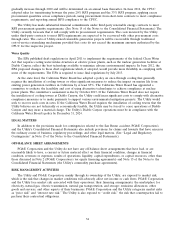PG&E 2012 Annual Report Download - page 48
Download and view the complete annual report
Please find page 48 of the 2012 PG&E annual report below. You can navigate through the pages in the report by either clicking on the pages listed below, or by using the keyword search tool below to find specific information within the annual report.these projects also face many of these risks. Changes in tax laws or policies, such as those relating ‘‘bonus’’
depreciation, may also affect when or whether a potential project is developed. In addition, reduced forecasted
demand for electricity and natural gas as a result of an economic slow-down, or other reasons, may also increase the
risk that projects are deferred, abandoned, or cancelled. Some of the Utility’s future capital investments may also be
affected by evolving federal and state policies regarding the development of a ‘‘smart’’ electric transmission grid.
In addition, differences in the amount or timing of actual capital expenditures compared to the amount and
timing of forecast capital expenditures authorized to be recovered through rates, can directly affect net income.
Further, if capital expenditures are disallowed, the Utility would be required to write-off such expenses which could
have a material effect on PG&E Corporation’s and the Utility’s financial condition and results of operations.
PG&E Corporation’s and the Utility’s financial results could be affected by the loss of Utility customers and decreased new
customer growth due to municipalization, an increase in the number of community choice aggregators, increasing levels of
‘‘direct access,’’ and the development and integration of self-generation and distributed generation technologies, if the CPUC
fails to adjust the Utility’s rates to reflect such events.
The Utility’s customers could bypass its distribution and transmission system by obtaining such services from
other providers. This may result in stranded investment capital, loss of customer growth, and additional barriers to
cost recovery. Forms of bypass of the Utility’s electricity distribution system include construction of duplicate
distribution facilities to serve specific existing or new customers. In addition, local government agencies could
exercise their power of eminent domain to acquire the Utility’s facilities and use the facilities to provide utility
service to their local residents and businesses. The Utility may be unable to fully recover its investment in the
distribution assets that it no longer owns. The Utility’s natural gas transmission facilities could be bypassed by
interstate pipeline companies that construct facilities in the Utility’s markets, by customers who build pipeline
connections that bypass the Utility’s natural gas transmission and distribution system, or by customers who use and
transport liquefied natural gas.
Alternatively, the Utility’s customers could become direct access customers who purchase electricity from
alternative energy suppliers or they could become customers of governmental bodies registered as community choice
aggregators to purchase and sell electricity for their residents and businesses. Although the Utility is permitted to
collect a non-bypassable charge for generation-related costs incurred on behalf of these customers, or distribution,
metering, or other services it continues to provide, the fee may not be sufficient for the Utility to fully recover the
costs to provide these services. Furthermore, if the former customers return to receiving electricity supply from the
Utility, the Utility could incur costs to meet their electricity needs that it may not be able to timely recover through
rates or that it may not be able to recover at all.
In addition, increasing levels of self-generation of electricity by customers (primarily solar installations) and the
use of customer net energy metering, which allows self-generating customers to receive bill credits for surplus power
at the full retail rate, could put upward rate pressure on remaining customers. Also, a confluence of technology-
related cost declines and sustained federal or state subsidies make a combination of distributed generation and
storage a viable, cost-effective alternative to the Utility’s bundled electric service which could further threaten the
Utility’s ability to recover its generation, transmission, and distribution investments.
If the CPUC fails to adjust the Utility’s rates to reflect the impact of changing loads, increasing self-generation
and net energy metering, and the growth of distributed generation, PG&E Corporation’s and the Utility’s financial
condition, results of operations, and cash flows could be materially adversely affected.
The operation of the Utility’s electricity and natural gas generation, transmission, and distribution facilities involve
significant risks which, if they materialize, can adversely affect PG&E Corporation’s and the Utility’s financial condition,
results of operations and cash flows, and the Utility’s insurance may not be sufficient to cover losses caused by an operating
failure or catastrophic event.
The Utility owns and operates extensive electricity and natural gas facilities, including two nuclear generation
units and an extensive hydroelectric generating system. The Utility’s service territory covers approximately 70,000
square miles in northern and central California and is composed of diverse geographic regions with varying climates
and weather conditions that create numerous operating challenges. The Utility’s facilities are interconnected to the
U.S. western electricity grid and numerous interstate and continental natural gas pipelines. The Utility’s ability to
earn its authorized rate of return depends on its ability to efficiently maintain and operate its facilities and provide
electricity and natural gas services safely and reliably. The maintenance and operation of the Utility’s facilities, and
44
























